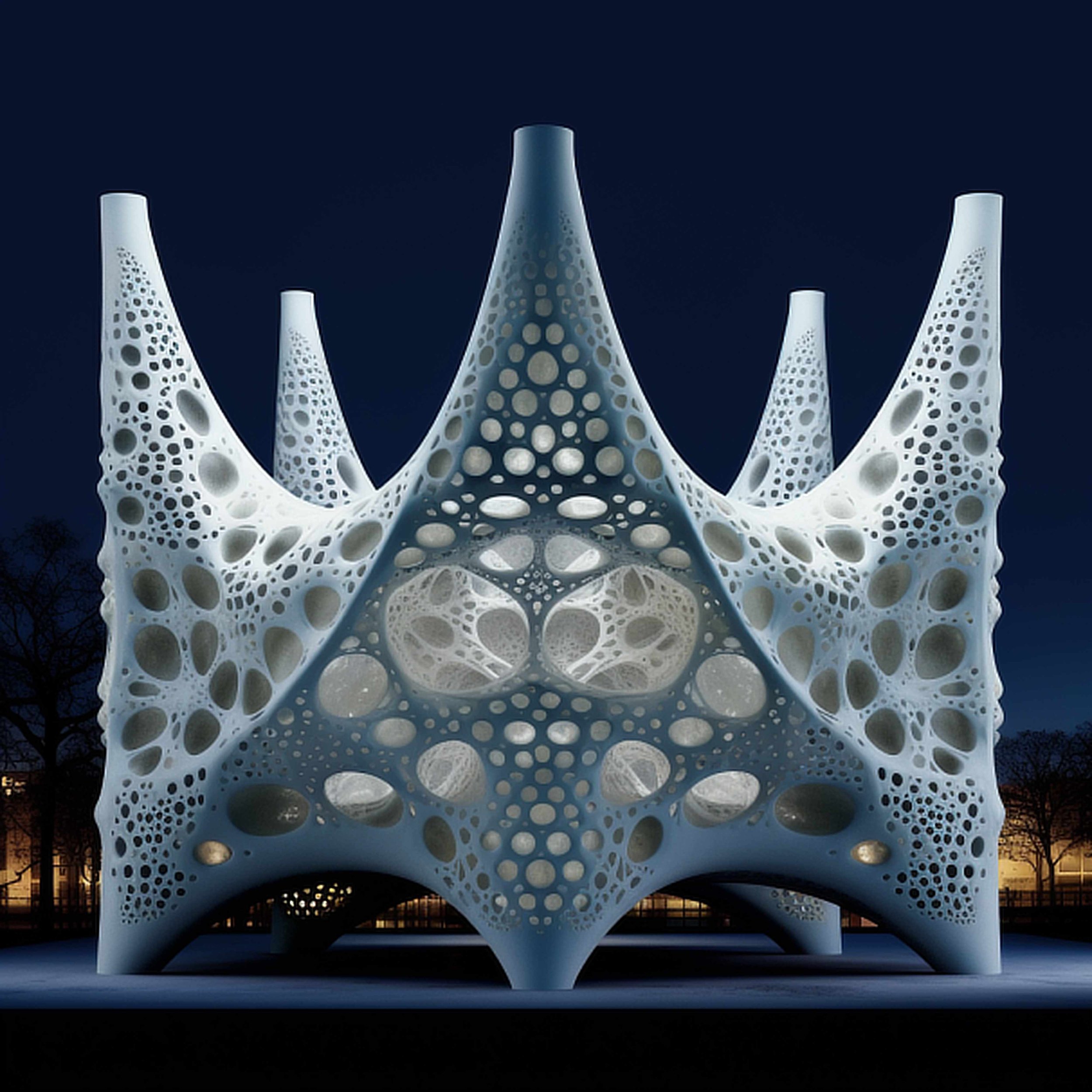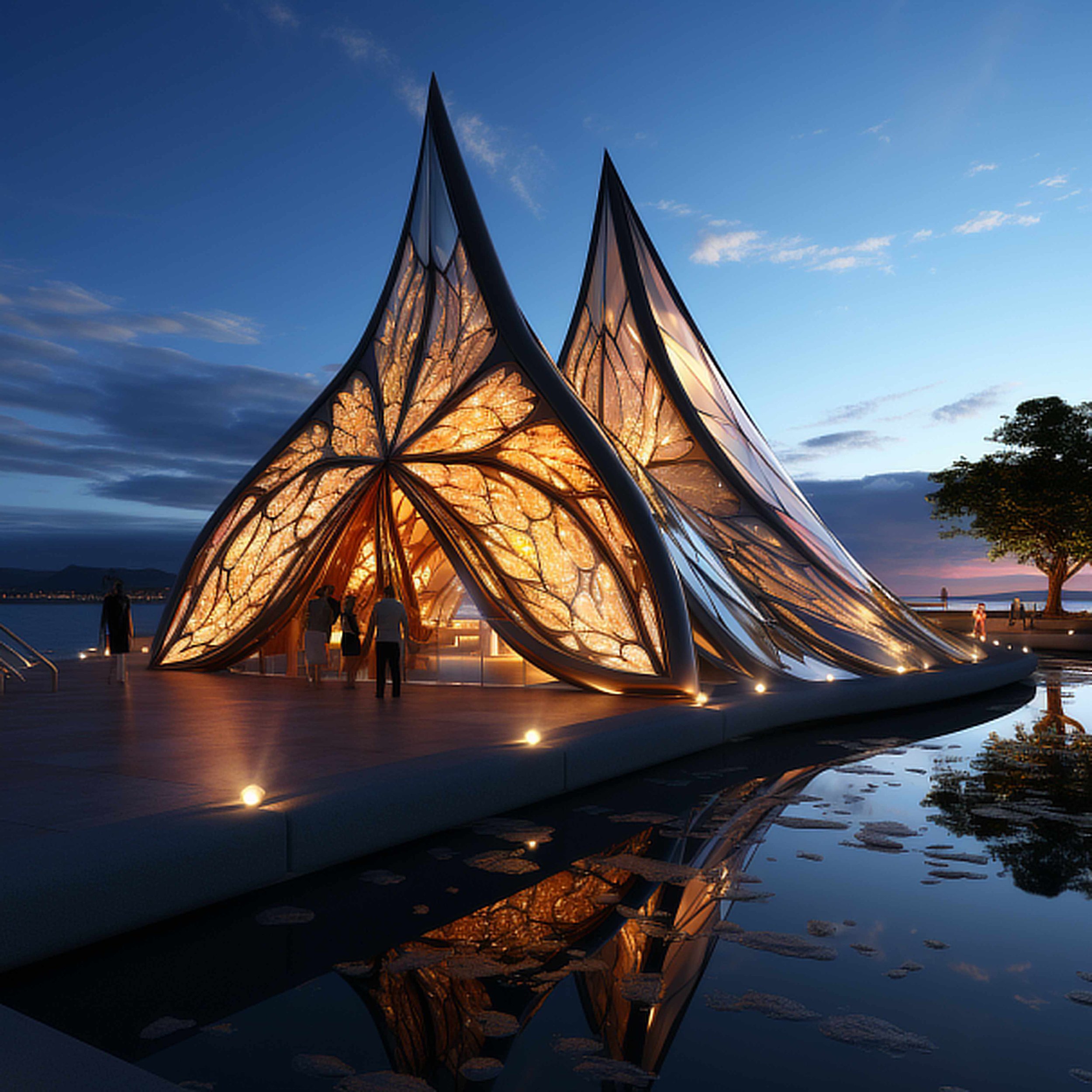
Diatoms
(15 minute read, lots of pictures)
This page is a growing library of research, art, and storytelling inspired by diatoms.
Diatoms are single-celled algae with shells made of silica that live in oceans, lakes, rivers, soils.
Last content update December 12, 2023
Image of a Thalassiosira weissflogii, a centric diatom
[Image Credit: Tian, Q. et al. Occurrence of structural aluminium (Al) in marine diatom biological silica:
visible evidence from microscopic analysis. Creative Commons Attribution 4.0 License, Link]
Working with Midjourney
Shared below are images created by Midjourney, a text-to-image generating AI. These images show strategies of diatoms and how they could be theoretically embedded in a building, design.
Note:
This page is a work in progress. For now, it is focused on science-fiction storytelling that imagines what might arise if we could mimic the adaptive strategies of diatoms. I’m researching “How” they do what they do and will continue to share what I find / create / imagine as the project progresses.
/imagine : Drawing Technically
I’ve long admired the drawing style of Ernst Haeckel and I wanted to see if Midjourney could help emulate this approach. The first two images arrived together and in the first picture I can almost imagine the building growing as a diatom frustule does - the building getting taller as girdle bands are added in the middle to lengthen the side walls.
I decided instead to go with the direction provided by the second image and imagined these spheres as attachments to existing buildings. One creates new indoor spaces against an office tower, another adds a tough outer shell over a weak spot protecting it from water and weather.
The final image: a new building form. Here the inventors figured out how to make the rounded silica walls stronger, lightweight, and transparent.





/imagine : Detailed Shells
Diatoms have an outer shell made of amorphous silica, the same material as glass. These inorganic cell walls have fine details of ridges, pores, and other structures that are thought to perform multiple functions including:
Control of buoyancy and sinking
Modulating light
Protecting from physical damage, crack propagation, UV rays, and viruses
(there’s more, for sure)
The below set of images attempt to capture the detailed nature of a diatom shell and to help us think about what functions those details, cavities, and attachments might provide to a human-scale built environment.





/imagine : Silica Greenhouses
Diatoms are photosynthesizing and they generate energy from the sun, like plants do. Within their cell walls they hold chloroplasts: organelles that create oxygen and sugar from water, sunlight, and CO2.
Here we envisioned a series of greenhouses, evolving through floating versions, factories, and conservatories; some are transparent glass domes and others are hard surfaces covered in gardens.
Giant-moss-covered structures and levels-connected-by-trees are all found in this universe.





/imagine : Growing Floors Between
Diatoms are able to reproduce by splitting their frustule apart and forming a second, smaller shell inside of each existing half. Some species are able to stay attached as they replicate, forming long chains that change in diameter along their length as the diatoms step up and down in size along the length.
~~~
In this series I imagine a bustling city that doesn’t have quite enough space for everyone.
Over years, the diatom strategy of growing silica chains is understood and replicated at larger and larger scales. At first experiments allowed people to add pre-fab rounded roof coverings to existing buildings, creating a new upper-level or improving weather protection and waterproofing. The technology quickly evolved and it quickly became inexpensive to provide the substructures that grow new floors with any new build.
Craftpersons took their construction skills to other coastal cities, testing silica-growing techniques in a wide range of settings and with different water-and-mineral mixes and learning how to integrate metals into these materials (as diatoms do): providing new properties and functions.
Durable and adaptable, many of the existing giant-sized structures started as small dwellings that grew into thriving communities. Some of these communities choose to cast off to sea — very often this was a group decision to avoid the high-density taxes these monoliths generated.
As they floated into the spacious oceans, these Islands of Thought spiraled, each exploring its own creative direction and occasionally meeting to trade culture and stories.





/imagine : Branching Ideas
This progression of images developed as I mixed diatom strategies with those of other organisms: Features of trees and branching patterns, sea urchins and flocking birds find home in these spaces.
~~~
I imagine the designers of this world challenged each other to outdo themselves along the edges of the possible. With each new generation, inventions and ideas mixed and remixed until one day the whole structure lifted from the ground and rippled apart.
And in a quick puff of activity,
…dissolved…
..
.





/imagine : Tri-sided Capsules
Diatom shells can survive millions of years on the bottom of oceans, withstanding the crushing weight of the water above and all-kinds-of-who-knows-what-else. Today these fossils help us take measurements of nutrients and pH from times before we could (or did) measure these things. An archive of Earth’s conditions.
For this next set of images I started with a request for Midjourney to create buildings based on the shape of a Triceratium diatom, a triangular species.
Midjourney wasn’t quite sure what I was looking for despite several attempted descriptions. It did however produce unexpected scifi outcomes that are perhaps even better?
I especially like illusory nature of the first image: a portal to another world?
…as this set developed I began to imagine these buildings as libraries and data centers. Like the diatoms, they would be time capsules; structures that capture and protect the knowledge and conditions of the present as it moves toward future, inspiring generations along the way.





AI x Biomimicry Competition
In the fall of 2023, NeverEnough Architecture hosted a course and competition asking participants to imagine a nature-inspired building and use AI to help generate the concept, renderings, and outcomes. Here I share the submission of my team as it designed a building inspired by diatoms and other strategies from the living world.
The Team:
So. How could we grow buildings — actually?
That’s where the research comes in. How do diatoms do it?
How do they collect, modify, and assemble silica to create intricate and durable glass-like shells that can survive intact for millennia?
I’ve done a lot of research. Some hints have been sprinkled above - and I’m going to continue digging. I’ll share what I learn as art, illustrations, 3d models, and other outcomes. If you are interested in this, please check back in.

